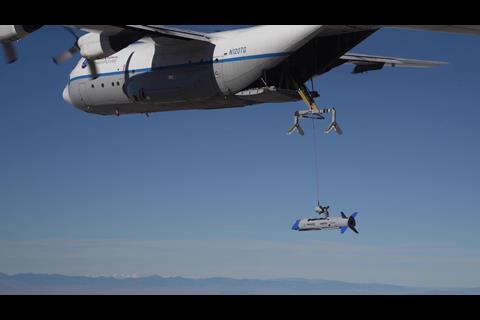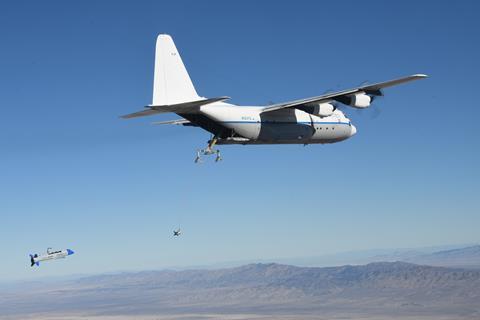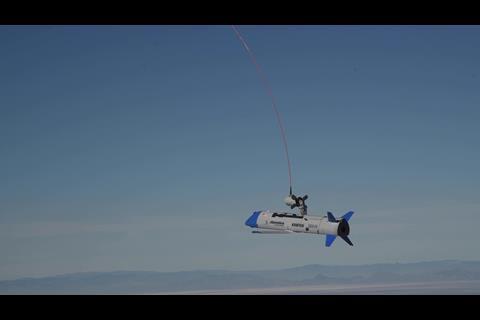The US Defense Advanced Research Projects Agency (DARPA) in October for the first time caught an airborne X-61 Gremlins unmanned air vehicle (UAV) using a mechanical arm and towed docking “bullet” deployed from the cargo ramp of a Lockheed Martin C-130.
The successful recovery of the experimental drone came after abortive and failed attempts over the course of three testing events since late 2019. DARPA used two Dynetics X-61 UAVs during its recent flight tests, one of which was destroyed due to electrical system failure, it said on 5 November.
The flight tests at Dugway Proving Ground in Utah validated all autonomous formation flying positions and safety features of the X-61 system, says DARPA.
“This recovery was the culmination of years of hard work and demonstrates the feasibility of safe, reliable airborne recovery,” says Lieutenant Colonel Paul Calhoun, programme manager for Gremlins in DARPA’s tactical technology Office. “Such a capability will likely prove to be critical for future distributed air operations.”
Four flights were conducted in October to gather data on aircraft performance, aerodynamic interactions between the recovery bullet and the UAV, and the dynamics of making contact with the UAV during retrieval, says the agency.
As part of the final experiment, DARPA retrieved and then refurbished an X-61 and conducted a second flight within “24 working-hours”. The refurbished UAV was recovered on the ground.
Five examples of the experimental X-61 drone were built as part of the Gremlins programme. An X-61 was also destroyed when its parachute failed to deploy during an initial test flight in 2019.
“Airborne recovery is complex,” says Calhoun. “We will take some time to enjoy the success of this deployment, then get back to work further analysing the data and determining next steps for the Gremlins technology.”
DARPA sees air-launch and retrieval as a way to expand the reach of UAVs, as well as a means to get multiple uses out of drones that might otherwise be difficult to recover.
In addition, by forgoing features necessary for runway launch and recovery, such as landing gear, these types of aircraft might be lighter weight and less expensive. The US Air Force calls the type “attritable”, meaning UAVs that are inexpensive enough to be lost to combat attrition and then cheaply replaced.
“The Gremlins’ expected lifetime of about 20 uses could provide significant cost advantages over expendable systems by reducing payload and airframe costs and by having lower mission and maintenance costs than conventional platforms, which are designed to operate for decades,” says DARPA.
Gremlins-like UAVs would likely be used for intelligence, surveillance and reconnaissance and other non-kinetic missions.
“They can also be launched from various types of military aircraft, keeping manned platforms safely beyond the range of adversary defences,” DARPA adds.
After the successful retrieval demonstration, the research agency says it is discussing next steps for the Gremlins programme.





































